
Accessible Instruction
UDL in Teaching and Learning
|
You have been asked to take this module as part of the Ontario Government's implementation of Accessibility for Ontarians with Disabilities Act (AODA). The goal of the AODA is to have a fully accessible Ontario by 2025. In an effort to increase accessibility in education, all educators, including those in post-secondary, are required to participate in training and have it completed by January 1, 2013. As your progress is tracked, please ensure you complete the evaluation at the end as your completion is forwarded to Human Resources. The university is required to report its numbers back to the government. If you teach at more than one school, you need only take the training once, then provide proof of completion at your other teaching locations. |
Let's Begin!
Please enter your Banner ID and home postal code below to begin the session.

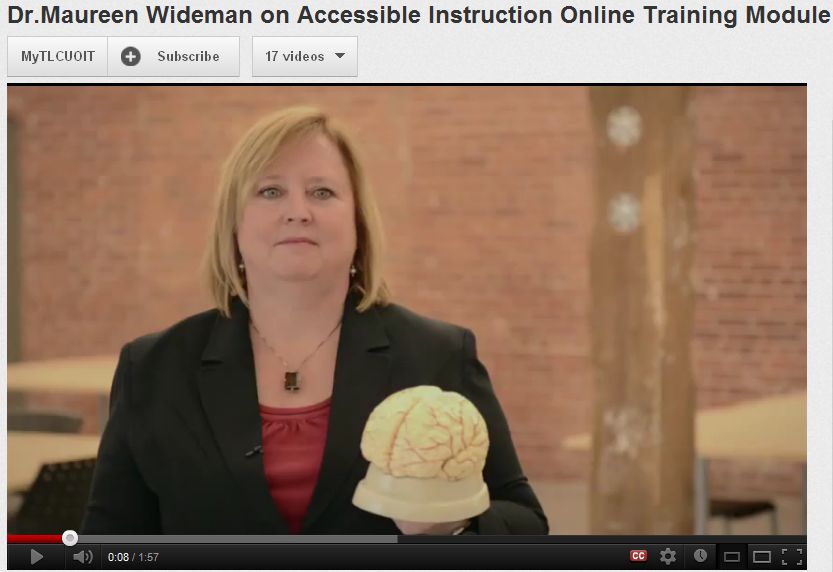
Let's begin by watching the Introductory Video (2 minutes).
How this module works
This module is focused on the researched-based principles of Universal Design for Learning (UDL). To navigate through, simply click on the numbered navigation found at the top of the page. Each section is divided into smaller segments. The content is made up of theory, short videos, examples as well as resources that you can download, read or use to evaluate your own courses.
There are two modes of evaluation at the end of the module - a short scenario or a multiple choice quiz. You have your choice as to which evaluation you would like to complete. Once you have completed the module and the evaluation, click the FINISH button and your completion will be sent to Human Resources.
As you familiarize yourself with the UDL principles and resources, you may discover that you have already incorporated many aspects of the UDL into your courses. Feel free to return to this module at any time to take advantage of the resources that are available to you.
UDL can benefit all students, not just those with disabilities.
Accessible instruction is most often referred to as Universal Design for Learning (UDL). UDL is based on the principles of universal design pioneered by architect Ronald Mace in the 1980s. Mace advocated for the design of buildings to be as accessible to as many people as possible. This has led to wider doorways, standardized heights for electrical outlets and switches, door handles that don't require gripping and twisting. These principles expanded beyond the built environment to design in other fields.
In the 1980s and 1990s, there was a push to provide students with disabilities (or exceptionalities as it was called) with access to education, in particular, post-secondary education. Much research and work was done to adapt the student to the learning environment by providing accommodations for the student after the learning process was set.
Researchers determined that when principles of universal design were applied to the learning environment, it improved opportunities for learning for all students. When UDL principles are incorporated into the course during its design and development, they lay the foundation with learning outcomes, activities, assessments, and teaching methods that improve accessibility for all learners (Rose & Meyer, 2002). A course designed using UDL principles is more flexible and student-centred, enabling the students to make choices or be more involved in the learning process by providing multiple ways to access content and express their learning.
Not only does UDL support the Ontario government's mandate under the AODA legislation, it also supports the strategic direction of UOIT for more learner-centric, enriching and innovative learning environments.
|
Handles that don't require gripping or twisting. |
Laundry that is front loading and raised for easier reach. |
Faucets that turn on with just a touch. |
Curb cuts improve mobility on city streets. |
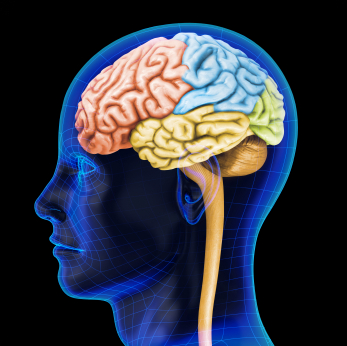 When we are teaching students we want the information to be remembered, processed and stored in the brain. We use techniques to assist this. Even when speaking, we use practices such as repetition, emphasis, and changing the cadence of our voices in order to make the load on the brain easier.
When we are teaching students we want the information to be remembered, processed and stored in the brain. We use techniques to assist this. Even when speaking, we use practices such as repetition, emphasis, and changing the cadence of our voices in order to make the load on the brain easier.
Print is a strong memory aid in that it can make the voice permanent. It enables the student to return to the text, to slow down or speed up the delivery of the materials and enable the student to focus on each word. Coupled with images, text becomes a powerful tool - the images present the information all at once rather than sequentially as with voice and text. It provides a different method for processing the information.
Images can also trigger an emotional response to the information increasing the potential for the information to become locked in memory. However, consider the impact on the learning when there is a deficiency in seeing, hearing or processing ability. This deficiency can lead to an impaired ability to learn.
Digital Media
Digital media provides the opportunity to improve learning at a substantial level. The ability to collaborate through networks, to share information, and build new knowledge can happen instantly. Information can be transformed, videos and graphics added, 3-D models developed and explored, interactive assessments developed - and all of it stored so that others can use it.
Technology enables choice in how students can interact with the materials depending on how best they learn. Digital media increases opportunity for multiple means of representation, expression and engagement. Textbook manufacturers have responded by providing e-tools with their books including test banks, interactive learning activities, videos, games, and more. Recently, Apple announced its iBook application for textbooks as it recognizes the shift from traditional print-based materials to highly graphical, interactive learning objects for learning.
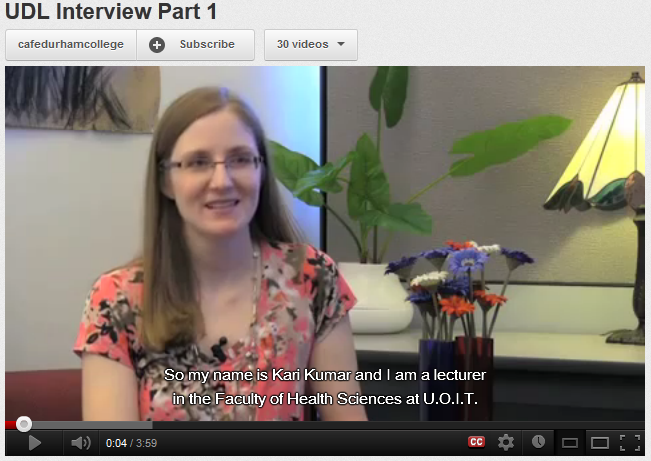
UOIT Instructor Kari Kumar discusses how she uses UDL in her classes. (4 minutes)
What are the benefits of using UDL?
UDL is based on three main principles:
See the Graphic Organizer - Universal Design for Learning
Book: Teaching Every Student in the Digital Age by David H. Rose, Anne Meyer, Nicole Strangman and Gabrielle Rappolt. Alexandra, Virginia: Association for Supervision and Curriculum Development, 2002.
E-book: How People Learn: Brain, Mind, Experience and School - by the Committee on Developments in the Science of Learning, eds. John D.Bransford, Ann L.Brown, and Rodney R.Cocking. (2000). Available at http://www.nap.edu/openbook.php?isbn=0309070368
Video: Why Universal Design for Learning, CAST co-founder David Rose
Video: TED Talk: Jill Bolte Taylor's stroke of insight

Source: https://assistivetechnologytidbits.wikispaces.com/About+UDL
Equity is not sameness.
While we've spent the last 20 years improving the built environment to ensure physical access to our buildings, we now recognize that there are many other barriers to learning. For the most part, we realize that we have a very diverse student population with different languages, cultures, genders and age groups. As instructors we try to ensure we use appropriate language that does not discriminate against one group, or incorporate examples into our courses that are more inclusive.
 Barriers to learning for students with disabilities can include attitudinal, organizational or practical. By recognizing and removing these barriers, we can assist our students in achieving a post-secondary education.
Barriers to learning for students with disabilities can include attitudinal, organizational or practical. By recognizing and removing these barriers, we can assist our students in achieving a post-secondary education.
Often in higher education, particularly as classes get larger, the learning experience is based on the transfer of content from the instructor to the student. The emphasis on print materials (even most PowerPoint presentations are predominantly print), and the dominance of one-way communication in the lecture hall, can make learning more difficult for many students, particularly for those who have a learning disability or other form of disability. It also does not promote deep learning that can occur through learning activities that are collaborative and engaging and designed to enable students to construct meaning from the experience.
Think about your assignments, your learning activities, your tests; did you realize that if you use one method of evaluation in your course, just multiple choice tests for example, you are providing an advantage to about 25 per cent of your students and disadvantaging the rest of the class? Some students will do really well on multiple choice tests whereas for others, it is not a true measure of their understanding of the materials.
Other barriers to learning can include time and money - UOIT has one of the highest levels of OSAP-funded students in the province necessitating that many of our students work. Does your course provide flexibility for students who have to work in order to go to school?
There are also cultural barriers to learning, language differences, learning styles (for example, a kinesthetic or hands-on learner may have difficulty in lecture-based courses), attitudinal barriers which can include confidence or motivational issues and of course, disability-related issues. For example, a student with a particular learning disability may struggle in a text-based online course where the student may need more frequent access to an instructor and peers for clarification of materials.
These are just a few of the many barriers that our students experience in post-secondary. Incorporating UDL principles can go a long way to assist in the removal of these barriers and improve learning.
Barriers to learning vary widely. Even if diagnosed with the same disability, the impact on the students may be quite different. While most students with disabilities will be working closely with their disabilities office and advisor on skills and strategies, it is recommended that the faculty member also discuss how best to meet the needs of the students. It is inappropriate to ask specifically about the diagnosis of the student, but conversations around assisting the student are encouraged. Also, feel free to contact your disabilities office regarding your students with disabilities.
Some typical barriers can include:
|
Barrier |
Difficulties |
Strategies |
|
Deafness |
-background noise can be distracting -multiple tasks such as writing notes, viewing videos, completing tasks are difficult when trying to lip-read or use sign language -new vocabulary, complex concepts may be difficult to comprehend -field trips can be challenging |
-ensure there is enough light so that the student can read lips / see interpreter -write new vocabulary on the board -explain new concepts with visuals -assign a student assistant/peer/note taker |
|
Visual Impairment |
-difficulty reading, taking notes -watching and learning from videos and demonstrations -interpreting graphics and charts |
-electronic notes, handouts readings electronic textbooks -note taker, assistant -consult with students as to how best meet his/her needs |
|
Learning Disabilities |
-difficulties vary and can include: short and working memory problems, persistent errors in numbers, spelling and grammar, note taking, organization, time management, misunderstanding |
-clearly structured notes and activities -consistency in course design -students with LD work closely with disability advisors to develop learning strategies |
|
Mobility, dexterity, chronic pain |
-poor pacing of workload can lead to fatigue -classroom design can make it difficult to see the board, sit for long periods of time -side effects of medication -use of computers, tools, etc. |
-electronic notes for use with technology -pausing long enough to allow students to ask questions -allowing students to stand or walk around |
|
Mental Health |
-barriers to learning can be related to symptoms or side effects of medication both psychological (anxiety, disorientation) or physical (stiffness, nausea, dizziness) -may have difficulty seeing the big picture -difficulty concentrating, panic or anxiety attacks, memory problems -sleep irregularities and fatigue -attendance issues |
-clearly structured course design -electronic notes -flexible or negotiated due dates -communication with student as to how best achieve course goals |
--------
Source: The Open University, 2006.

Daniel, a UOIT student with Asperger's Syndrome, discusses some of his challenges at university (1.5 minutes).

UOIT student, Andrew, discusses how to assist students with vision impairments (4 minutes).
 One of the benefits of this campus is the robust network and technological tools as well as our innovative support systems available to faculty members and students. Technology has enabled the practices of universal design for learning to become more diverse. Digital media are flexible, interactive and malleable. Digital media can enable faculty members to transform traditional learning materials like print-based readings into engaging, explorative or experiential activities that foster deeper learning.
One of the benefits of this campus is the robust network and technological tools as well as our innovative support systems available to faculty members and students. Technology has enabled the practices of universal design for learning to become more diverse. Digital media are flexible, interactive and malleable. Digital media can enable faculty members to transform traditional learning materials like print-based readings into engaging, explorative or experiential activities that foster deeper learning.
Instructors and students using networked digital materials can select the most suitable medium or use multiple media simultaneously. They can also convert material from one media to another on the fly, modify the appearance of information within one medium, delve more deeply or connect laterally to other concepts through links, and communicate with many different people through networked computer (Rose & Meyer, 2002, p. 78).
Those who may have physical impediments such as difficulty moving around the classroom or holding a book, for example, can benefit from digital versions by allowing navigation on the computer, note taking, and communication. If writing is a problem, speech-to-text software can record their work and transform it into text.
Don't feel you have to do this on your own. UOIT has a talented Teaching and Learning unit with multimedia developers, ideograph, and consultants who can assist you in incorporating interesting and engaging learning materials and activities into your courses. To discuss the possibilities, please contact: the Teaching and Learning Centre - teachingandlearning@uoit.ca.
Adding value to web instruction, by Sheryl Brugstahler, PhD
The future is in the margins: The role of technology and disability in educational reform, by David Rose, Ed.D. and Anne Meyer, Ed.D.
References:
Rose, D., Meyer, A., Strangman, N., and Rappolt, G. (2002). Teaching Every Student in the Digital Age. Alexandra, Virginia: Association for Supervision and Curriculum Development.
The Open University. (2006). Making Your Teaching Inclusive. Available at: http://www.open.ac.uk/inclusiveteaching/pages/inclusive-teaching/barriers-to-learning.php
The goal is not to modify the curriculum but to maintain the standards and rigor through an accessible curriculum.
 Changing a course to ensure it is accessible does not require the instructor to reduce its rigor or place the integrity of the course or degree in jeopardy. The goal is not to modify the curriculum to reduce the requirements, but to maintain the learning goals and allow more flexible methods for learning and achieving those goals. There may be times when an accessible course will require accommodations for a student with a disability (eg. longer test times), but an accessible course design improves the learning opportunity for all students and significantly reduces the need for accommodation.
Changing a course to ensure it is accessible does not require the instructor to reduce its rigor or place the integrity of the course or degree in jeopardy. The goal is not to modify the curriculum to reduce the requirements, but to maintain the learning goals and allow more flexible methods for learning and achieving those goals. There may be times when an accessible course will require accommodations for a student with a disability (eg. longer test times), but an accessible course design improves the learning opportunity for all students and significantly reduces the need for accommodation.
For example, if you are using videos in your course, those videos may require captioning depending on the needs of the students (eg. a student who is hard of hearing or deaf). What research has found is that captioning not only benefits students who have hearing disabilities, but also assists students whose first language is not English, those who may have processing difficulties, or those who may be watching the video in a noisy area such as a bus, cafe or cafeteria where hearing it may be difficult.
Accommodation refers to changes made to the course after the course has been set to enable a student who has a disability to gain access to the learning. For example, a sign language interpreter may be required, large print books or materials, longer testing times, a note taker, specialized computer equipment, chairs or other tools. The course goals remain the same, but accessing the materials may have to be altered depending on the student's disability. The more accessible we make a course, the less accommodation is required.
Modification refers to changes to the course outcomes and, therefore, to the learning and assessment that is done. For example, at Durham College, modified curricula has enabled students with intellectual disabilities to attend post-secondary and take classes through the Community Integration through Co-operative Education (CICE) program. With a modified curriculum, students receive a specialized certificate from the program upon completion.
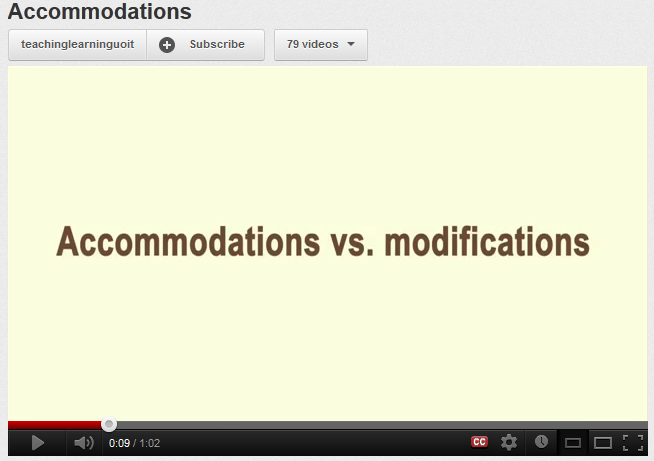
Meghan Houghton, Director of Learning and Disability Services, discusses accommodations versus modifications (1 minute).
Using the principles of UDL in course design does not require that faculty members surrender academic freedom. Academic freedom is the acknowledgment that academics and universities must be given the freedom to pursue and create knowledge and to bring that knowledge to students. The expertise of the faculty member provides students with opportunity to learn from the leaders in that field. Making that knowledge as accessible as possible helps to ensure that more students are able to learn and benefit from that expertise.
Additional Resources:
The Ontario Human Rights Code and Academic Freedom
Present information and content in different ways.
 Learners differ in the ways that they perceive and comprehend information. For example, those with sensory disabilities (e.g., blindness or deafness); learning disabilities (e.g., dyslexia); language or cultural differences, require different ways of accessing content. Others may simply understand information quicker or more efficiently through other means rather than printed text. Learning and transfer of learning occurs when multiple representations are used because they allow students to make connections within, as well as between, concepts. In short, there is not one means of representation that is optimal for all learners; providing options for representation can improve the learning opportunity in your course (National Center on Universal Design for Learning, 2012).
Learners differ in the ways that they perceive and comprehend information. For example, those with sensory disabilities (e.g., blindness or deafness); learning disabilities (e.g., dyslexia); language or cultural differences, require different ways of accessing content. Others may simply understand information quicker or more efficiently through other means rather than printed text. Learning and transfer of learning occurs when multiple representations are used because they allow students to make connections within, as well as between, concepts. In short, there is not one means of representation that is optimal for all learners; providing options for representation can improve the learning opportunity in your course (National Center on Universal Design for Learning, 2012).
Learning is most effective when it is multimodal - when material is presented in multiple forms. Students benefit from having multiple means of accessing and interacting with material and demonstrating their knowledge through evaluation.
For example, an audio description that accompanies the text description of an assignment, provides students with another modality to increase comprehension of the assignment criteria. If they have difficulty with the text, the audio format may increase their understanding of the expectations of the assignment.
For example: The following an auditory description of an assignment that is also posted as a Word document on a course site.
Text: Therapeutic Assignment Accompanying audio file: Therapeutic assignment description (5 minutes)
Video: Multiple Means of Representation (2.5 minutes)
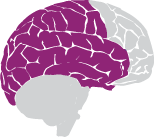 The recognition networks are essential in most higher order thinking tasks. For example, reading requires pattern recognition, decoding and comprehension. In mathematics they are necessary to recognize numbers, shapes and equations (Rose & Strangman, 2007). The recognition network in the human brain requires exposure to a variety of examples. The Internet can provide a wealth of examples that can be linked to from the course materials. Faculty members are no longer required to build it all - sharing information, the backbone of the Internet, provides ample opportunity to access information from sources around the world.
The recognition networks are essential in most higher order thinking tasks. For example, reading requires pattern recognition, decoding and comprehension. In mathematics they are necessary to recognize numbers, shapes and equations (Rose & Strangman, 2007). The recognition network in the human brain requires exposure to a variety of examples. The Internet can provide a wealth of examples that can be linked to from the course materials. Faculty members are no longer required to build it all - sharing information, the backbone of the Internet, provides ample opportunity to access information from sources around the world.
Instructors can use media such as video to highlight critical features of readings, assignments or when marking. Computers have the capacity to zoom in on graphics or "spotlighting" on important aspects can be used when creating videos. As another example, an audio file of the marked students' assignments can provide a more human touch to the marking process and provide more in depth feedback.
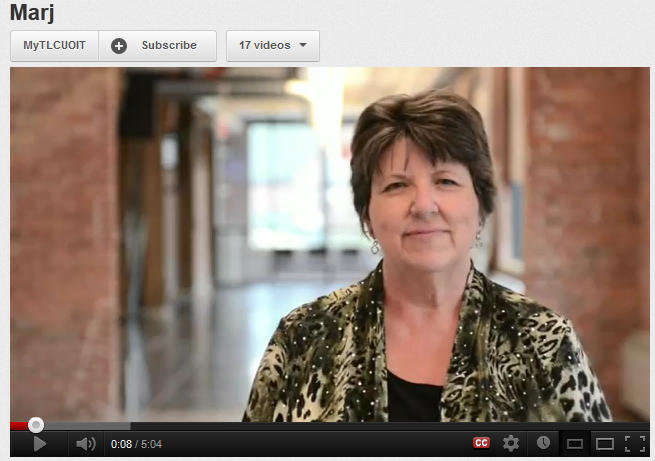
Marj Rempel, Director of Teaching and Learning at UOIT
discusses how she uses video to mark papers (5 minutes).
Digital media can increase access to written work by enabling the fonts to be enlarged or adjusting the colour or contrast; screen readers can read the text aloud or transform it to Braille. Screen readers can highlight certain words, provide definitions, correct spelling and grammar, search for terms or link to similar information.
Here are some examples of how you can provide options in your classroom:
Some technological suggestions:
Multiple Means of RepresentationDo you create a learning environment in which material and content are presented in a variety of ways?
|
|
|
UDL Guideline |
Example |
|
Your course syllabus clearly describes the content and your expectations of the students. (e.g. measurable outcomes, weekly learning objectives) |
Use your outline as an advance organizer to go over expectations for the following week i.e. reading, videos to watch, etc.
|
|
You present information in multiple formats (e.g., lecture, text, graphics, audio, video, hands-on exercises) |
Add an audio file explaining a major assignment. |
|
You begin each lecture with an outline of what will be covered.
|
Start every class with an agenda so students know what to expect during class. |
|
You summarize key points throughout the lecture, and tie these points to the larger course objectives.
|
Use an active learning activity such as clickers, a game or review questions to review the key points of your lesson. |
|
You post electronic equivalents of paper handouts and required reading assignments in alternative formats such as audio and video.
|
Post all course documents on the learning management system so students can access them whenever needed. Documents should be in an accessible format ie. Microsoft Word, Excel, PowerPoint (see tutorials below). |

See these short Tutorials on how to make your documents
and PowerPoint presentations accessible.
Faculty Focus: How a graphic syllabus can bring clarity to course structure
References:
National Center on Universal Design for Learning. (2012). UDL Guidelines – Version 2.0. Available at: http://www.udlcenter.org/aboutudl/udlguidelines/principle1
Rose, D. and Strangman, N. (2007). Universal Design for Learning: meeting the challenge of individual learning differences through a neurocognitive perspective. Universal Access in the Information Society, 5:381-391. DOI 10.1007/s10209-006-0062-8
Provide options for how students express what they have learned.
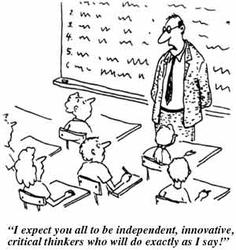
Source: https://assistivetechnologytidbits.wikispaces.com/About+UDL
 Learners differ in the ways that they can navigate a learning environment and express what they know. For example, individuals with significant movement impairments (e.g., cerebral palsy), those who struggle with strategic and organizational abilities (executive function disorders), those who have language barriers, all approach learning tasks very differently. Some may be able to express themselves well in written text but not speech (National Center on Universal Design for Learning, 2012).
Learners differ in the ways that they can navigate a learning environment and express what they know. For example, individuals with significant movement impairments (e.g., cerebral palsy), those who struggle with strategic and organizational abilities (executive function disorders), those who have language barriers, all approach learning tasks very differently. Some may be able to express themselves well in written text but not speech (National Center on Universal Design for Learning, 2012).
It should also be recognized that action and expression require a great deal of strategy, practice, and organization - another area in which learners can differ. In reality, there is not one means of action and expression that will be optimal for all learners; providing options for action and expression can greatly improve learning in your class. To provide multiple and flexible means of expression is to provide students alternatives for demonstrating what they have learned.
Allowing students to choose can be an effective method for students to demonstrate their learning, however, there are times when the purpose of the assignment is to challenge the student to go beyond their comfort zone and try something new in order to expand their abilities. An option is to provide, for example, four different types of assignments in the semester and students are required to complete three. Another example is having a test or exam that is divided into sections where each section has different types of questions such as, multiple choice, short answer, case study, essay or calculations. Each section is weighted the same. Students must complete three of the five sections to complete the test.
Multiple Means of Expression |
|
|
Do you create a learning environment in which students can express their comprehension in multiple ways?
|
|
|
UDL Guideline |
Examples |
|
You encourage students to demonstrate knowledge and skills in ways other than traditional tests and exams (e.g., written essays, projects, portfolios, journals).
|
Use a variety of evaluation methods to allow students to express what they know in multiple ways. Example: Introductory Biology may include quizzes, case studies, model building, and oral presentation rather than just traditional tests and a final exam. |
|
You provide students with choice in evaluation methods to demonstrate their learning.
|
Provide students options to demonstrate mastery of the course learning outcomes.
Provide students the opportunity to choose which type of assignment they would like to complete, for example, you may choose one of the following evaluation methods: a poster presentation, research report or creating a video. |
|
You incorporate technologies that facilitate class communication and participation.
|
Use of discussion boards or blogs also allow students who need more time to reflect on a topic and have the ability to participate.
Use of virtual clickers allows all students to participate without feeling centred out. |
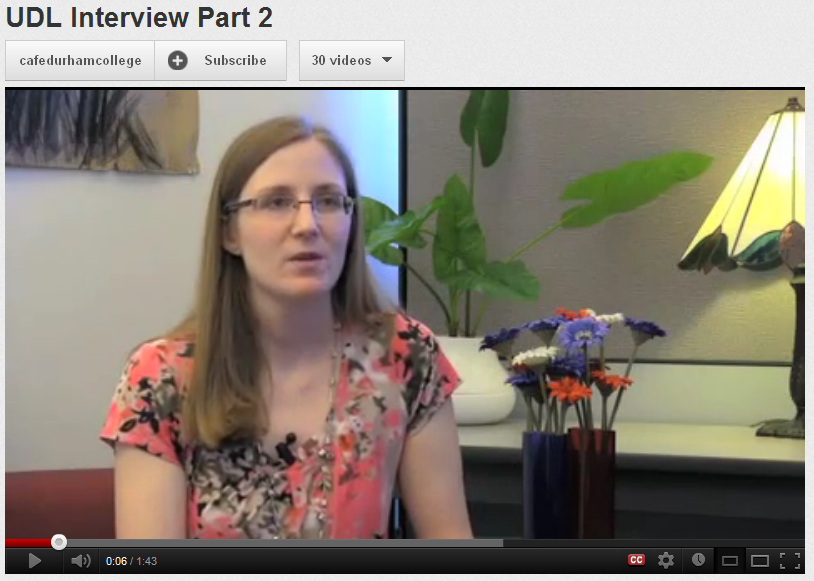
UOIT Instructor Kari Kumar provides more detail about
how she incorporates UDL in her health science course (2 minutes).
Additional Resources:
Faculty Focus: A Role for Student Choice in Assignments?
Sample Assignment using UDL guideline Multiple Means of Expression
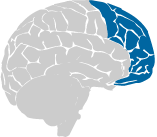 Strategic networks are required for executive functioning such as: selective attention, planning, organization, and self-monitoring. They guide our behaviours and in response to learning, are used to set goals, focus, and monitor progress. If there are problems, it is the strategic network that will evaluate the situation and develop a plan (Rose & Strangman, 2007). Digital media can provide opportun ties for multiple means of practice in order for a student to develop the strategic skills required to learn the concept. Links to different models or modes can assist a student's understanding of the concept. This enables the student to create better mental models of the concept, and therefore, be more strategic in further learning such as determining relevance or concentrating on more difficult aspects, etc.
Strategic networks are required for executive functioning such as: selective attention, planning, organization, and self-monitoring. They guide our behaviours and in response to learning, are used to set goals, focus, and monitor progress. If there are problems, it is the strategic network that will evaluate the situation and develop a plan (Rose & Strangman, 2007). Digital media can provide opportun ties for multiple means of practice in order for a student to develop the strategic skills required to learn the concept. Links to different models or modes can assist a student's understanding of the concept. This enables the student to create better mental models of the concept, and therefore, be more strategic in further learning such as determining relevance or concentrating on more difficult aspects, etc.
Communication technologies can be used to give immediate feedback such as the discussion board, email, Skype, online office hours. Technology has improved accessibility to the professor enabling quicker clarification of issues, connection to other students, and collaboration (Rose, et al, 2002).
Additional Resources:
Faculty Focus - Think Alouds shed light on how students grapple with content
References:
National Center on Universal Design for Learning. (2012). UDL Guidelines - Version 2.0. Available at: http://www.udlcenter.org/aboutudl/udlguidelines/principle2
Rose, D., Meyer, A., Strangman, N., and Rappolt, G. (2002). Teaching Every Student in the Digital Age. Alexandra, Virginia: Association for Supervision and Curriculum Development.
Rose, D. and Strangman, N. (2007). Universal Design for Learning: meeting the challenge of individual learning differences through a neurocognitive perspective. Universal Access in the Information Society, 5:381-391. DOI 10.1007/s10209-006-0062-8
Stimulate interest and motivation for learning.

In reality, there is not one means of engagement that will be optimal for all learners in all contexts; providing multiple options for engagement increases the potential for learning. Some learners are highly engaged by spontaneity and novelty while other are disengaged, even frightened, by those aspects preferring strict routine. Some learners might like to work alone, while others prefer to work with their peers (National Center on Universal Design for Learning, (2012).
Here are some examples of how you can provide options in your classroom:
We each learn most effectively when the challenge is enough to stretch us beyond our current level of functioning while still being within our capacity to learn effectively (Vygotsky, 1962). Offer multiple resources at a variety of levels to meet the unique needs of individual learners. For example:
Choice of Learning Context
Diverse learners have unique preferences and requirements regarding their learning context. Address this diversity by offering a variety of options:
Multiple Means of Engagement |
|
|
Do you create a learning environment in which learners are challenged, excited and motivate about what they are learning?
|
|
|
UDL Guideline |
Examples |
|
You challenge students with meaningful assignments.
|
Create evaluations that are performance based and allow students to demonstrate the learning outcomes. |
|
You create a class climate in which student diversity is respected.
|
At the beginning of the semester, have students generate a list of "ground rules" for classroom conduct. Be sure to post the agreed upon list on the course site and refer to when necessary in class. |
|
You give prompt and instructive feedback on assignments.
|
Post grades as soon as possible on Blackboard Allow students to hand in a "rough draft" of a paper or assignment. Have peers assess them based on a rubric. |
|
Do you supplement lecture and reading assignments with visual aids (e.g., photographs, videos, diagrams, interactive simulations)?
|
Use advance organizers to help students read with intent and purpose.
Provide students with a list of questions to answer when reading.
Have students watch a video on the topic as well as reading the chapter. |
|
Do you make yourself available to students during office hours in flexible formats (e.g., face-to-face, email, online chat, telephone)?
|
Post your office hours on Blackboard as well as on your office door. Realize that many students cannot meet with you face-to-face for various reasons i.e. work, children, etc. Online meetings may be a solution. |
|
Do you provide tasks that allow for active participation, exploration and experimentation?
|
Use a variety of active learning strategies to engage a variety of learners in your classroom. See the Teaching and Learning website for examples or book an appointment with a faculty development consultant. |
|
Do you invite personal response, evaluation and self-reflection to content and activities?
|
Use course evaluation surveys to help you determine aspects of your teaching that are working and which need to be changed |
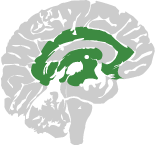
The affective network is required to interpret the world in terms of emotional impact and significance. They act as an emotional filter as we view everyday actions and make decisions based on emotion, motivation and biological drives. They assist in prioritizing and influence the decision to persist or shut down when things get difficult (Rose & Strangman, 2007).
Emotional difficulties may impede a student's ability to interpret text and concepts. Images or visual media can convey strong emotional messages and may assist the student to understand the information. Frequent feedback can provide incentive and motivation to improve. Graphic organizers and a well-structured course can assist with a feeling of being overwhelmed by the requirements.
Digital versions of materials can mean multiple ways of accessing and processing the information. Reading, viewing, or interactive activities can assist in learning. Students can choose how they are assessed whether it is from creating their own responses with a video or multimedia presentation, writing a paper, responding to direct questions, web sites, concept maps, posters, etc. A bank of online resources provided by the textbook manufacturer can provide the instructors with many opportunities to choose the level of challenge for the students.
Learning Object: Metabolic Fate of Macronutrients
Microbiology Virtual Lab
References
National Center on Universal Design for Learning. (2012). UDL Guidelines - Version 2.0. Available at: http://www.udlcenter.org/aboutudl/udlguidelines/principle3
Rose, D. and Strangman, N. (2007). Universal Design for Learning: meeting the challenge of individual learning differences through a neurocognitive perspective. Universal Access in the Information Society, 5:381-391. DOI 10.1007/s10209-006-0062-8
Vygotsky, L. (1962). Thought and language. Cambridge, MA. MIT Press.
 One of the most common complaints about UDL is that it can be difficult to implement in large classes. There is no doubt that large classes are becoming more common in post-secondary and that offering choice to 200 students can seem overwhelming, but it is possible. Faculty members question how they can make the marking fair across a variety of different assignments. You may be able to use one rubric to mark all assignments as the objectives of each assignment may be the same. For example: students have demonstrated their understanding of the concepts; students have applied the concepts, students have analyzed the concepts, etc. in order to complete the assignment.
One of the most common complaints about UDL is that it can be difficult to implement in large classes. There is no doubt that large classes are becoming more common in post-secondary and that offering choice to 200 students can seem overwhelming, but it is possible. Faculty members question how they can make the marking fair across a variety of different assignments. You may be able to use one rubric to mark all assignments as the objectives of each assignment may be the same. For example: students have demonstrated their understanding of the concepts; students have applied the concepts, students have analyzed the concepts, etc. in order to complete the assignment.
Think about how you manage your TAs - can you assign a TA to each type of assignment?
Student supports through UDL:
When teaching, keep in mind those characteristics of some of the worst classes or teachers that you've had - and don't repeat them. For example:
How to improve learning in the large class:
Source: University of North Carolina, Charlotte. Faculty Center for Teaching and e-Learning.
 There can be many reasons for evaluating students in courses. Ask yourself, "Am I doing an assessment of learning, or doing an assessment for learning?"
There can be many reasons for evaluating students in courses. Ask yourself, "Am I doing an assessment of learning, or doing an assessment for learning?"
Often, the purpose of a test is to determine the student's level of learning at a particular time. But even a test can be an opportunity for further learning. Take up the test in class. Go over the answers, allow students to ask questions. Revisiting the concepts can help reinforce the learning. Often faculty members feel there isn't time to take the test up in class so they advise students to come and see them during office hours. Most students do not attend (time, work, other classes, etc.) so they miss the opportunity to further discuss the concepts with their professor or TA.
"Group work is brutal and I hate it." (UOIT student, 2009)
As instructors, we are encouraged to have students work in collaborative and cooperative learning groups as this experience can enable students to take responsibility for their own learning, develop critical thinking skills, and increase both the learning and retention of the materials. But group work can be a difficult process for students if they feel that it has not been handled fairly. Are members of the groups decided randomly or are students allowed to choose their group mates. There is an argument for either depending on the overall goal of the assignment. Do you assess the product and/or the process? Is just one grade awarded for the group or do you provide an opportunity for students to assess each other depending on their contribution? Do you have a method for monitoring group discussions and progress? Are groups required to schedule work time outside of class time? This can make it difficult for students who work, have family responsibilities or other issues.
Example of self-assessment rubric.
Example of peer-assessment rubric.
Example of a team contract.
If you want to learn more about effective group assignments, you can contact the teachingandlearning@uoit.ca.
Video: Dr. Richard Felder, Chemical Engineer, discusses active learning
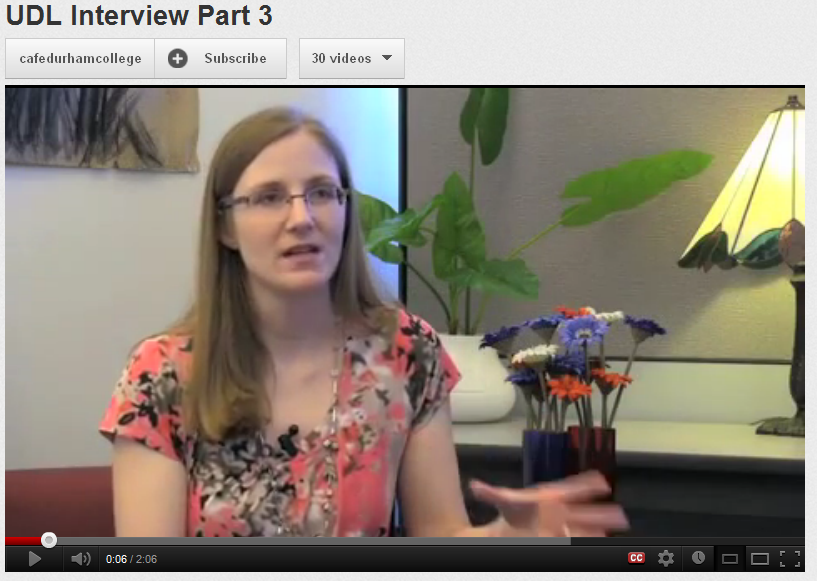
UOIT Instructor Kari Kumar discusses UDL and effective teaching (2 minutes).
 When first getting started it is best to use the UDL guidelines when developing new material. The UDL principles and resources can assist you making decisions about current and new learning materials, lessons, and assessments and curriculum.
When first getting started it is best to use the UDL guidelines when developing new material. The UDL principles and resources can assist you making decisions about current and new learning materials, lessons, and assessments and curriculum.
For example, if you include a variety of active learning strategies, post notes in multiple formats, and allow students to choose a variety of assessment options in your course you will have implemented some of the principles. These approaches are linked in that they share the same goal of creating curriculum that meets the diverse needs, strengths, and interests of your students to improve overall learning.
You can begin by applying the following questions to your curriculum:
Learning Materials and Activities
Feedback and Assessment
Trying to rethink one's curriculum and employing the UDL principles can seem like a daunting task. We encourage you to start small and work your way through your courses. Use the checklists provided below to guide the process. Feel free to get feedback from your students. A more accessible curriculum can benefit all your students.
The materials and methods teachers use can either present students with barriers to understanding or enhance their opportunities to learn. By developing and applying UDL, we can minimize barriers and realize the promise each student brings to school (Rose and Meyer, 2002, p. 8).
If you have any questions or wish to explore options for your course, you can contact UOIT's Teaching and Learning Centre.
Checklists:
A checklist for making distance learning programs welcoming and accessible to all students, by Sheryl Burgstahler, PhD
An Educators Checklist by CAST.org
UID Quick-Start Checklist by the University of Guelph
MERLOT: Video Case studies of UDL in the classroom
Reference:
Rose, D., Meyer, A., Strangman, N., and Rappolt, G. (2002). Teaching Every Student in the Digital Age. Alexandra, Virginia: Association for Supervision and Curriculum Development.
Thank you for taking the time to complete this module.
This is just an introduction to the principles of Universal Design for Learning. Feel free to return to this module to access the resources and other materials.
Please make sure you complete ONE of the evaluations below. YOU MUST CLICK THE FINISH BUTTON AT THE BOTTOM OF THE PAGE to forward your results to Human Resources. Your completion will then be recorded.
Choose:
Case Study
OR
Multiple Choice Quiz
To record your completion of this training, please click the FINISH button.

Thank you!